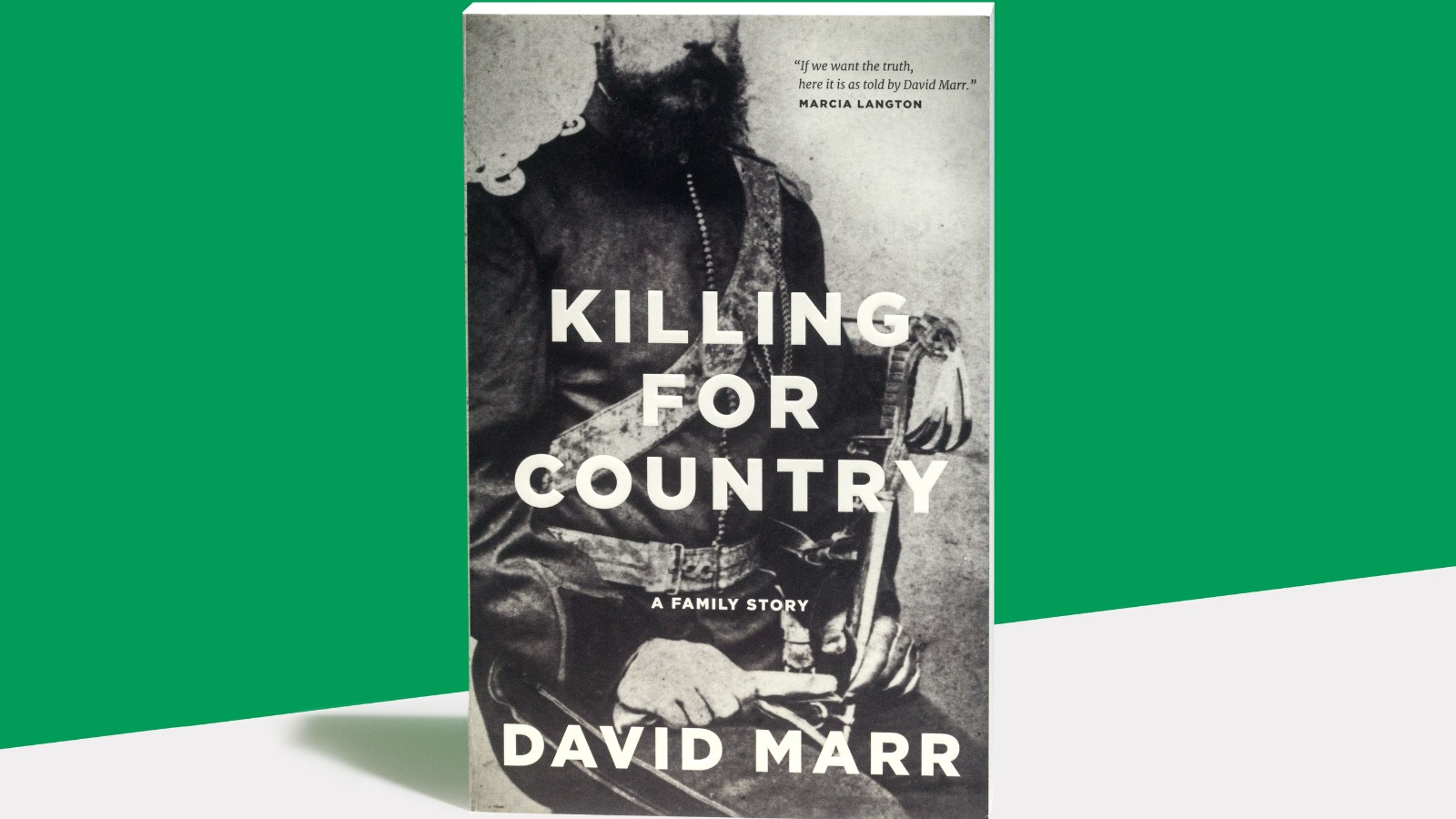Non-Fiction Shortlist

Title: Killing for Country: A Family Story
Author: David Marr
Publisher: Black Inc.
A gripping reckoning with the bloody history of Australia’s frontier wars.
David Marr was shocked to discover forebears who served with the brutal Native Police in the bloodiest years on the frontier. Killing for Country: A Family Story is the result – a soul-searching Australian history.
This is a richly detailed saga of politics and power in the colonial world – of land seized, fortunes made and lost, and the violence let loose as squatters and their allies fought for possession of the country – a war still unresolved in today’s Australia.
Photography by Sarah Walker
Judges’ report
Aboriginal men were recruited or coerced into the Native Police – ‘young men in a broken world’; white settlers volunteered – officers doing “gentlemen’s work” – and among their number were members of David Marr’s own family. In Killing for Country, Marr confronts this history with rigour and integrity, marking an important national shift in which the privileged beneficiaries of violent dispossession no longer leave truth-telling to First Peoples. Marr’s solid research and powerfully engaging writing ensures that the early colonial conditions in which violence and lies could proliferate are all too easily recognisable today. This is an Australia we all need to understand.
Extract
The young man drove his flock over the Liverpool Range. The sky was immense. Magnificent plains lay before him. Grass ran for miles as level as the sea. This was country where squatters would make fortunes and found dynasties. But fortune was a fickle thing in the Colony. So far, she had favoured Edmund Blucher Uhr extravagantly, plucking him from a poor street by the Thames when his sister married the Sydney merchant whose sheep he was driving down to a crossing on the Mooki. It was spring. The air was full of birds.
Is it not a good place, Uhr asked. His guide agreed. “But I should not like to put my sheep on it and drive away the cattle of those who have sat down here.” Two huts stood on the far side of the river. Uhr didn’t care. “They are a set of cattle-stealing rascals, and I should have no compunction.” His guide agreed they were rascals. “But I should not trouble myself about that. I should go farther, and look out for myself. They are here.” Uhr was unpersuaded. He had crossed the range with orders to seize a great swathe of the finest land in New South Wales. “My sheep will soon scatter the cattle.”
The two men rode down the river for 12 miles, claiming 150,000 acres of the Liverpool Plains for the merchant Richard Jones. The soil was black and deep. This is Kamilaroi[1] country, but neither Jones nor Uhr doubted for a moment the land was theirs for the taking. Jones paid nothing for these acres. His only obligation was to stock them. Uhr would soon be running 30,000 sheep along the Mooki. New South Wales was perfecting a unique form of colonial conquest: invasion by sheep.
The Kamilaroi call this corner of their country the great plains, Corbon Comleroy. “Big fellow water all over the plains,” one of the old people told a stockman. “They used to have canoes and go fishing from one island to the other.” The Kamilaroi were a warrior nation about 12,000 strong and their country covered 30,000 square miles running from the plains west and north into the valleys of the Peel, the Barwon, the Gwydir and the Macintyre. These were the Welsh, Scottish and English names the invaders pinned to the map. But ancient Kamilaroi names survived, perhaps too beautiful to be lost: Quirindi, Wee Waa, Collarenebri, the Mooki. Even before Edmund Uhr brought his sheep to the plains in 1835, maps had begun to mark the places Kamilaroi would be slaughtered. The names are still there: Waterloo Creek, Gravesend, Slaughterhouse Creek, Vinegar Hill and, most haunting of all, Myall Creek.
*
Richard Jones never raised his voice. Not for him the caterwauling and brawls dubbed Botany Bay tactics. He was quiet, fearless and a mighty Christian who would seize from the Aboriginal people by influence, chance and cunning 600,000 acres of their country. His lieutenant in the enterprise was the young man he rescued from the London slums. Though Jones became one of the richest figures in New South Wales and shaped its politics under four governors, this silky man with a plain name makes only fleeting appearances in the big histories. Many dismissed him in his own day as pious and penny-pinching. But Richard Jones was a great white carp in the colonial pond, half hidden in the weeds, always feeding and always dangerous.
He came to Sydney in 1809 as a clerk in a merchant house. The Joneses had land and a little brewery on the Welsh borders. “Small country gentlefolks,” his daughter Elizabeth called them. “Papa was sent to London for educational advantages & when fitted for it, he obtained a clerkship in a leading London Mercantile Firm.” This was Alexander Birnie & Co., traders in wool and whale oil. As an elder of the Scottish church, Birnie worked hand in glove with the Missionary Society in the Pacific, where God and trade were advancing together on the fringes of the Empire. His house shipped evangelists to Tahiti, New Zealand and the Marquesas, whence their boats returned to London laden with timber, flax and oil. Neither trade nor evangelism extended to the Aborigines of New South Wales. How different this story might have been had they anything to sell the invaders.
Birnie sent his restless brother James to set up a branch of the house in Sydney. He in turn brought out twenty-three-year-old Jones. Birnie was a drunk who left his young clerk in charge of the business for months and years at a time. Responsibility came easily to Jones. Over the next few years, he sold rum from Bengal and household goods from London. He set up a whaling fleet in the Tasman and began to ship wool to England. He handled other people’s money with faultless tact. He collected debts for merchants in India, China and London; he administered the estates of the mad and the dead. Trust was his capital. His prospects grew as he became known as a Christian merchant of impeccable honesty.
Sydney was a makeshift town built on a few bays of the finest harbour in the world. Its imperial trappings were modest. Windmills lined the hills. Pubs were dotted everywhere. Stock wandered the streets. A gallows stood close to the graveyard. Though there was money to be made in the town, punishment remained the purpose of the place. Chain gangs clanked through the streets every morning. Hundreds of convict servants worked for masters who had only to feed, clothe and house them in return for their labour. Jones employed and despised them. “Very bad indeed,” was his verdict of the labour they gave. And convict discipline? “The punishments are much slighter than they were; which, no doubt, is the cause of all the insubordination.” All his life Richard Jones was a committed foe of insubordination. He would not have convicts in his house. “My own private servants were always free.”
The Colony had yet to recover – if it ever did – from the upheaval of the Rum Rebellion that overthrew Governor William Bligh. Though a petty tyrant, Bligh was often in the right. He thought army officers and wool growers like John Macarthur should obey the law like everyone else. So they deposed him. Jones was there to watch the fireworks that marked the arrival of his successor, Colonel Lachlan Macquarie, who already knew a thing or two about insurrection. Macquarie had fought the American rebels in Charleston and New York. After the American War of Independence, rebellion was never entirely out of the question in the Empire. Men who overthrew a governor might once have been dragged back to London and hanged. These rebels were barely punished. The enduring lesson of the Rum Rebellion was the power of the big men of New South Wales. Governors took them on at their peril.
[1] Also Gamilaraay or Gamilaroi.
About the author

Photo by Lorrie Graham
David Marr’s books include Patrick White: A Life, The High Price of Heaven, Dark Victory (with Marian Wilkinson), Panic and six bestselling Quarterly Essays. He has written for The Sydney Morning Herald, The Age, The Saturday Paper, The Guardian and The Monthly, and has served as editor of The National Times, reporter for Four Corners and presenter of ABC TV’s Media Watch.
Related Posts

Read
Anne-Marie Te Whiu Receives The Next Chapter Alumni Poetry Fellowship
2 Apr 2024

Read
What's on in April: Resident Organisation Round Up
28 Mar 2024

Read
Blak & Bright First Nations Literary Festival returns in 2024
7 Mar 2024

Read
What's on in March: Resident Organisation Round Up
29 Feb 2024

Read
Hot Desk Extract: International
23 Feb 2024

Read
Hot Desk Extract: The Rooms
23 Feb 2024
Share this content